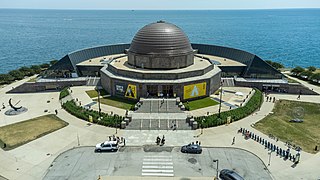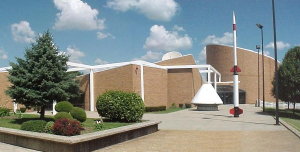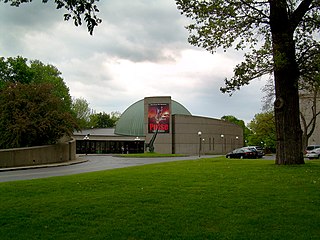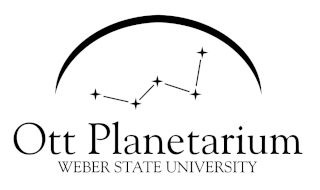
A planetarium is a theatre built primarily for presenting educational and entertaining shows about astronomy and the night sky, or for training in celestial navigation.

The Adler Planetarium is a public museum in Chicago, Illinois, dedicated to astronomy and astrophysics. It was founded in 1930 by local businessman Max Adler. Located on the northeastern tip of Northerly Island on Lake Michigan, the Adler Planetarium was the first planetarium in the United States. It is part of Chicago's Museum Campus, which includes the John G. Shedd Aquarium and The Field Museum. The Planetarium's mission is to inspire exploration and understanding of the universe.

Morehead Planetarium and Science Center is located on the campus of the University of North Carolina at Chapel Hill. As a unit of the university, Morehead receives about one-third of its funding through state sources, one-third through ticket and gift sales, and one-third through gifts and grants.

The Fernbank Science Center is a museum, classroom, and woodland complex located in Atlanta. It is owned and operated by the DeKalb County School District, which announced in May 2012 it was considering closing the facility to cut its annual budget, then quickly shelved the plan after public outcry. The nearby Fernbank Museum of Natural History is a private non-profit organization that is separate from the Science Center.

The Cernan Earth and Space Center is a public planetarium on the campus of Triton College in the Chicago suburb of River Grove. It is named for astronaut Eugene Cernan (1934-2017), who flew aboard the Gemini 9 and Apollo 10 missions and, as commander of Apollo 17, was the last astronaut to leave his footprints on the Moon.

Charles Eugene Flandrau was an American lawyer who became influential in the Minnesota Territory, and later state, after moving there in 1853 from New York City. He served on the Minnesota Territorial Council, in the Minnesota Constitutional Convention, and on the Minnesota territorial and state supreme courts. He was also an associate justice on the Minnesota Supreme Court.

The Saint Louis Science Center, founded as a planetarium in 1963, is a collection of buildings including a science museum and planetarium in St. Louis, Missouri, on the southeastern corner of Forest Park. With over 750 exhibits in a complex of over 300,000 square feet (28,000 m2), it is among the largest of its type in the United States.

The William M. Staerkel Planetarium is a planetarium at Parkland College in Champaign, Illinois. It is the second largest planetarium in the state, the largest being the Adler Planetarium in Chicago, and has the first Carl Zeiss M1015 opto-mechanical star projector installed in the western hemisphere. The Staerkel Planetarium provides science education programs and light show entertainment to as many as 40,000 people each year. It has a 50-foot dome, seats 144, and private group and school show reservations can be made beyond the regular public offerings.

A Zeiss projector is one of a line of planetarium projectors manufactured by the Carl Zeiss Company. Main models include Copernican (1924), Model I (1925), Model II (1926), Model III (1957), Model IV (1957), Model V (1965), Model VI (1968), Spacemaster (1970), Cosmorana (1984), Skymaster ZKP2 (1977), and Skymaster ZKP3 (1993).

The Fleet Science Center is a science museum and planetarium in Balboa Park in San Diego, California. Established in 1973, it was the first science museum to combine interactive science exhibits with a planetarium and an IMAX Dome (OMNIMAX) theater, setting the standard that most major science museums follow today. It is located at the east end of the El Prado Drive walkway, next to the Bea Evenson Fountain and plaza in central Balboa Park.

Armagh Planetarium is a planetarium in Armagh, Northern Ireland. It is located close to the city centre and neighbouring Armagh Observatory in approximately fourteen acres of landscaped grounds known as the Armagh Astropark.
Digistar is the first computer graphics-based planetarium projection and content system. It was designed by Evans & Sutherland and released in 1983. The technology originally focused on accurate and high quality display of stars, including for the first time showing stars from points of view other than Earth's surface, travelling through the stars, and accurately showing celestial bodies from different times in the past and future. Beginning with the Digistar 3 the system now projects full-dome video.

The Rose Center for Earth and Space is a part of the American Museum of Natural History in New York City. The Center's complete name is The Frederick Phineas and Sandra Priest Rose Center for Earth and Space. The main entrance is located on the northern side of the museum on 81st Street near Central Park West in Manhattan's Upper West Side. Completed in 2000, it includes the new Hayden Planetarium, the original of which was opened in 1935 and closed in 1997. Neil deGrasse Tyson is its first and, to date, only director.

The Strasenburgh Planetarium is a public planetarium located at 663 East Avenue in the city of Rochester, New York. It is named after its benefactors, Edwin and Clara Strasenburgh. It is a department of the Rochester Museum and Science Center. The Planetarium was dedicated on September 14, 1968. The 65-foot-diameter Star Theater originally seated 240 people. The original seats were replaced in 1985; as currently configured, the theater seats 225. The Star Theater houses the first Zeiss Mark VI planetarium projector; it is still in daily operation. The planetarium received world-wide attention by being the first to be computer automated. It was known for both its technical and programming innovations.

The Ott Planetarium is a planetarium at Weber State University in Ogden, Utah, USA. The facility is named for Layton P. Ott and the Ott family. The planetarium is operated by university students and is a place of learning for audiences and staff alike.

Grace Hodgson Flandrau was an American author of novels, short stories and journalistic pieces. Although she achieved a certain degree of critical acclaim for several of her novels, short stories and some of her journalism career during the 1920s, 1930s and 1940s, she faded from public literary view in the later part of her life. Flaudrau's reputation is re-emerging as a prominent writer due to a 2007 biography, which has been promoted by, among others, Garrison Keillor.

B. M. Birla Planetarium is a large planetarium in Chennai, India. The fifth B. M. Birla planetarium in the country, it is located at Kotturpuram in the Periyar Science and Technology Centre campus which houses eight galleries, namely, Physical Science, Electronics and Communication, Energy, Life Science, Innovation, Transport, International Dolls and Children and Materials Science, with over 500 exhibits. Built in 1988 in the memory of the great industrialist and visionary of India B. M. Birla, it is considered the most modern planetarium in India, providing a virtual tour of the night sky and holding cosmic shows on a specially perforated hemispherical aluminium inner dome. Other Birla planetariums in India include the M. P. Birla Planetarium in Kolkata, the Birla Planetarium in Hyderabad, and the planetariums in Tiruchirapalli and Coimbatore.

The Buhl Planetarium and Institute of Popular Science Building, also known as the "People's Observatory", is located at 10 Children's Way in the Allegheny Center neighborhood of Pittsburgh, Pennsylvania.

Abrams Planetarium is the planetarium on the campus of Michigan State University, Michigan, United States.

Fiske Planetarium is one of the largest planetariums in the United States, educating the public on astronomy and astrophysics since 1975. They offer a diverse range of fulldome films, live talks, laser and liquid sky music shows, as well as public gatherings for astronomical and NASA-related events. It is a constituent of the Department of Astrophysical and Planetary Sciences at the University of Colorado Boulder.




















